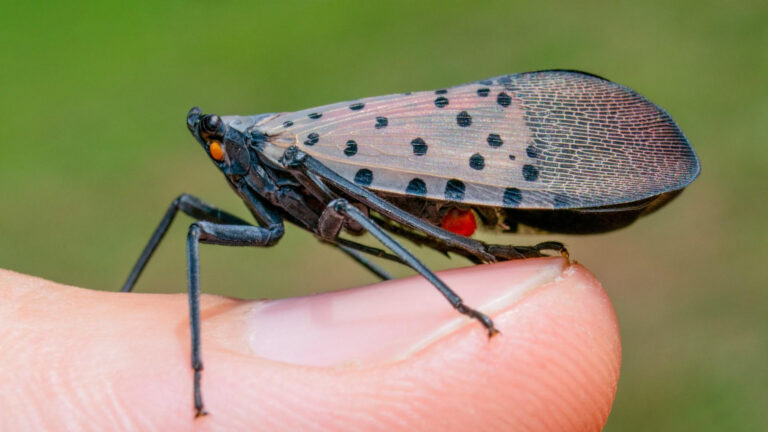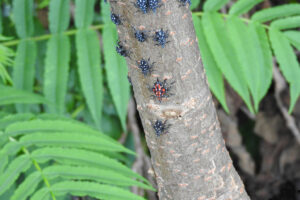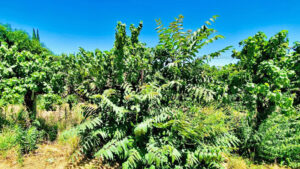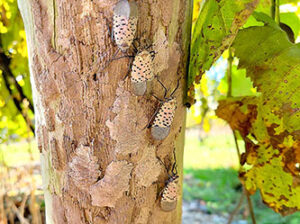
When a few viable spotted lanternfly eggs attached to giant artwork survived cleaning in Nevada and made it to Sonoma County earlier this year, it sent shivers through the California winegrape industry.
“It was terrifying to know it got in,” said California Association of Winegrape Growers (CAWG) President Natalie Collins. “Once that happened, we really wanted to make sure everyone was aware of the pest, every part of its life cycle and just understand what to be on the lookout for.”
CAWG had been actively educating its members for some time describing the lanternfly’s threat to the industry and how to identify the pest. But Collins said the hitchhiking egg masses prompted the association to ramp up its efforts. CAWG sent out a press release to alert the general public as well, and several media outlets picked up on it.
Continuing to spread the word is just part of preparing for the pest’s arrival, since it’s not a matter of if it will arrive but when, she said.
Since 2000, state and county agricultural inspectors have checked more than 2,000 sites across the state, including rail yards, highway rest stops and fairgrounds, for the spotted lanternfly (SLF) without finding it. During 2023, state inspectors checked an additional 300 high-risk sites in 31 counties between August and December when adult lanternflies are most active.

As part of the state’s action plan, the CDFA enacted an exterior quarantine in 2021 that prohibits introduction of SLF into the state. Included in the regulations are inspection protocols and restrictions on materials coming from states with known SLF populations.
USDA researchers continue to study potential biological control agents as well as develop pheromone lures for use in monitoring traps. And UC Riverside researchers just wrapped up research into a potential parasitoid wasp.
Throughout it all, Collins said CAWG continues to advocate for research funding both at the state and federal level. In addition, the Pierce’s Disease/Glassy-winged Sharpshooter Board recently funded two lanternfly projects.
One led by UC Davis Plant Pathologist Neil McRoberts will involve preparing for SLF arrival with a focus on area-wide responses. The other, led by Plant Virologist Christina Rosa of Penn State University, plans to examine the interactions of SLF and Pierce’s disease.

Crystal Ball Predictions
The recent wakeup call involved a 30-foot-tall metal art installation coming from New York state laden with SLF eggs. The CDFA Truckee border inspection station found the eggs and sent the artwork back to Nevada for hot power washing with detergent. Even so, three egg masses still snuck past reinspection and made their way to the piece’s final destination, Sonoma County. During another inspection, which involved taking the metal artwork apart, Sonoma County agricultural commissioner inspectors found the additional viable egg masses and destroyed them.
When SLF will arrive in California in earnest is anyone’s guess, although a computer model developed by North Carolina State University’s Biological Invasions group offers some estimates. Published in 2022, the model forecasted a low probability of the pest arriving on the West Coast by 2027, assuming no treatments to control the population occur. There’s a high probability SLF will reach the West by 2033 under the same assumptions.
One of the challenges with these types of model results, said Senior Research Scholar Chris Jones, is they quickly need to be updated.
“The interesting aspect of working with invasive species and modeling is what you know to be true changes quickly after the paper is published because the science changes so quickly,” Jones said.
Information available when they ran the model theorized SLF could only reproduce successfully on its preferred host, tree of heaven. Since then, he said scientists have found the pest also can successfully reproduce on black walnut and grapes. The Biological Invasions group plans to update and rerun the SLF prediction model with the new data.

Proactive Biological Control
After being surprised by Asian citrus psyllid numbers that exploded in Los Angeles basin residential areas in the early 2010s, Mark Hoddle wondered about taking more proactive approaches to future invasive pest infestations. As director of UC Riverside’s Center for Invasive Species Research, his area of expertise involves finding natural enemies that can help control invasive species.
“What I learned was it took us several years to get those natural enemies into California,” Hoddle said, referring to Asian citrus psyllid. “I talked to CDFA and told them, ‘After dealing with ACP, I think we need to be better prepared. There are obviously threats coming to California, and SLF is one of those. We’d be fooling ourselves to assume they could never come here.’”
He proposed a concept known as “proactive biological control,” which involves searching for and testing potential biological control candidates before a pest’s arrival. This is an about-face from past practices, when researchers would wait until an invasive species arrived in California even though it was established and spreading throughout other parts of the U.S. Then they’d begin work to find predators and parasitoids and test their compatibility and environmental safety.
Hoddle is wrapping up a three-year CDFA-funded project that examined whether a minute stingless wasp, Anastatus orientalis, found in SLF’s native habitat in China could potentially be used to help control the pest once it arrives in California.
Considered an egg parasitoid, female wasps lay their eggs in SLF eggs. The wasp eggs hatch and the larvae develop inside, eventually killing the SLF eggs and emerging as adults.

As with any biological control candidate, researchers put A. orientalis through a battery of tests to ensure it would only go after SLF and wouldn’t negatively affect native lanternflies or other non-target insect species.
In tests conducted at UC Riverside’s Insectary and Quarantine Facility, Hoddle said the wasp had too wide a host range and also oviposited in eggs of native Southwestern lanternflies, stinkbugs and various Lepidoptera (butterflies and moths). USDA colleagues on the East Coast conducted similar screenings.
“After a lot of testing both on the East and West Coasts, we came to the conclusion it attacked way too many species,” Hoddle said.
Although A. orientalis failed the screenings, he still considered the work successful. “At least we’ll be better prepared than if we had done nothing,” Hoddle said. “It would take us about three years to figure this stuff out, so we’re already ahead. We can use that biocontrol money and resources for other things to manage SLF.”
USDA researchers in the East continue to look at another small wasp native to parts of China: Dryinus browni. This small stingless parasitoid goes after second- and third-instar SLF nymphs.

Get to Know the ‘Hitchhiking Vampire’
Sometimes dubbed the “hitchhiking vampire,” the spotted lanternfly (SLF) is not actually a fly but a planthopper in the order Hemiptera. It sucks sap from plants, including grapevines and apple, cherry, almonds and stone fruit trees, weakening them.
In severe infestations, it may kill grapevines. Altogether, the pest has a host range of more than 100 agricultural and ornamental plants. Topping the host list is tree of heaven, itself an invasive species from the SLF’s homeland of Taiwan and China.
Spotted lanternfly also excretes sugary honeydew, which attracts black sooty mold that can block the sun’s rays and reduce photosynthesis. And Penn State research, which has not yet been peer reviewed, showed the pest potentially can vector the Xylella fastidiosa bacterium responsible for Pierce’s disease.
SLF was first detected in the U.S. in Pennsylvania in 2014, although it my have been there for a few years prior. Since then, the pest has spread westward and so far has been confirmed in 20 states all west of the Mississippi River.
SLF is not a strong flier, preferring to hop, and much of its dispersion has been aided by movement of egg masses laid on countless inanimate objects, including outdoor furniture, equipment, tools, automobiles, toys, recreational vehicles, rail boxcars and even artwork.
A 2020 Penn State University study estimated SLF was responsible for $554 million in annual crop losses and nearly 5,000 job losses per year where it’s established in the Northeast. High on its list of preferred hosts are grapevines, and Pennsylvania grape growers have reported losing thousands of vines to the pest.
Educating California residents about the pest and its threats is an ongoing effort. Among those leading the charge is UCCE. During a recent lunchtime Zoom meeting, more than 300 mostly Master Gardeners logged on to listen to UC IPM Advisor Cindy Kron, who’s based in Sonoma County. She talked about how to identify SLF, its habitat, its relation to tree of heaven and what to do if they suspect the pest.
CDFA also continues to promote “Snag it. Snap it. Report it.” Basically, if you see a pest you suspect is SLF, capture it, take a photo and report it to the local farm advisor or ag commissioner’s office.
And Mark Hoddle, director of the UC Riverside Center for Invasive Species Research, said he checks iNaturalist almost daily to see if anybody has posted images of SLF or other invasive pests in California. An online community of citizen scientists, iNaturalist.org hosts more than 207 million observations from more than 3.3 million observers worldwide.
For more information on spotted lanternfly, visit CDFA’s SLF pest profile at https://tinyurl.com/y8zunsfz.











